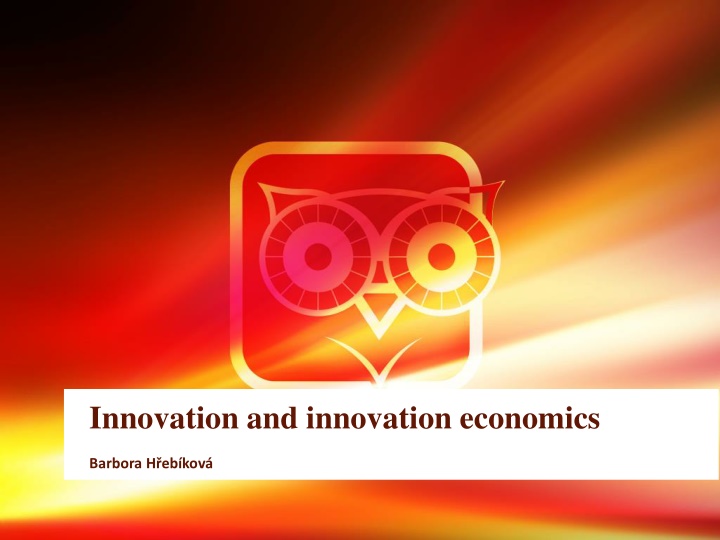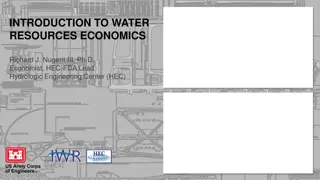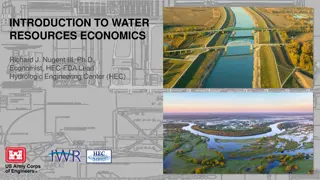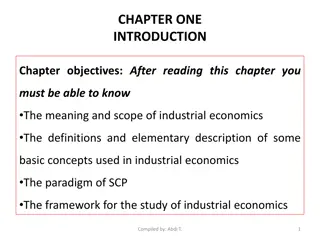Innovation and innovation economics
Delve into the world of innovation economics with a focus on the knowledge economy, economic growth, and the impact of innovation on competitiveness. Explore topics like intellectual property rights, innovative firm models, innovation measurement, and more. Dive into compulsory and recommended literature, examination criteria, and semester projects in this dynamic field.
Uploaded on Mar 07, 2025 | 0 Views
Download Presentation

Please find below an Image/Link to download the presentation.
The content on the website is provided AS IS for your information and personal use only. It may not be sold, licensed, or shared on other websites without obtaining consent from the author.If you encounter any issues during the download, it is possible that the publisher has removed the file from their server.
You are allowed to download the files provided on this website for personal or commercial use, subject to the condition that they are used lawfully. All files are the property of their respective owners.
The content on the website is provided AS IS for your information and personal use only. It may not be sold, licensed, or shared on other websites without obtaining consent from the author.
E N D
Presentation Transcript
Innovation and innovation economics Barbora H eb kov
Innovation and innovation economics Seminars Barbora H eb kov Departement of Economics, FEM, CULS
Innovation and innovation economics Subject content Knowledge economy and innovation economics. Current economic megatrends and phenomenas of current economics. Definition of innovation and classification. Microeconomic effects of innovation. Intellectual property rights. Innovative Firms - models of innovation process, drivers and barriers to successful innovation process. Measurement of innovation. Innovation and competitiveness. Innovation and economic growth. Innovation and labour market. Diffusion of innovation. Innovation system. Innovation policy.
Innovation and innovation economics Literature Compulsory literature: Greenhalgh, Ch., Rogers, M. (2010): Innovation, Intellectual Property, and Economic Growth. 384 s. New Jersey: Princeton University Press. ISBN: 978-0-691-13798-8. Hall, B.H., Rosenberg, N. (2010): Handbook of the Economics of Innovation. Amsterdam: North Holland. 804 s. ISBN: 978-04-445-1995-5. Recommended literature: Fagerberg, J., Mowery, D.C., Nelson, R.R. (2006): The Oxford Handbook of Innovation. Oxford: Oxford University Press. 680 s. ISBN: 978-0-19-926455-1. Feldman, P.M., Link, A.N., Siegel, D. (2012): The Economics of Science and Technology. An Overview of Initiatives to Foster Innovation, Entrepreneurship, and Economic Growth. New York: Springer-Verlang New York Inc. 135 s. ISBN: 978-14-613-5335-5. Griliches, Z. (2007): R&D and Productivity: The Econometric Evidence. Chicago: University of Chicago Press. 400 s. ISBN 0-226-30886-3. Korres, G.M. (2008): Technical Change and Economic Growth: Inside the Knowledge Based Economy. Fernham: Ashgate Publishing Limited. 372 s. ISBN 978-1-84014-992-0. OECD/Eurostat (2018): Oslo Manual 2018: Guidelines for Collecting, Reporting and Using Data on Innovation. Paris: OECD Publishing. 254 s. ISBN 978-92-64-30455-0. Academic Journals: Economics of Innovation and New Technology Innovations Journal Of Innovation Economics & Management (I-JIEM)
Innovation and innovation economics Exam and Credit Credit: awarded at the end of the semester under following conditions: participation on seminars (one absence); obtaining at least 60 points: semester project (100 points: 50% presentation). Exam: a combination of: written 30 minutes, to pass: 60% of the total number of points; oral?
Innovation and innovation economics Semester project Powerpoint presentation: 30 minutes; Everybody must be prepared for oral presentation on the 3rd seminar (30th of October)!!! Manuscript: template on Moodle, the manuscript must not be longer than 15 pages (respect the style of the template); Submission via moodle; Deadline: Week 9!, Exact time we will tell you later.
Innovation and innovation economics Semester project Structure: Abstract should give a pertinent overview of the semester project. Introduction should briefly place the study in a broad context and highlight why it is important. The current state of art is reviewed in the introduction and aims of the study are presented. Materials and Methods should inform about data and methods used in the study. It should give readers enough information to repeat the research. Quantitative analysis must be performed! Results provide a precise description and interpretation of results. Discussion and conclusion summarizes the main findings and place them in context of previous findings. References
Innovation and innovation economics Semester project It is necessary to use expert and scientific papers, for example: - Web of Science, - Scopus - Etc. Note, every source must be market. In case of plagiarism I will not give you credit!!!!!
Innovation and innovation economics Topics of semester project Bioeconomy and circular economy Sharing economy Digital currency Globalisation and deglobalisation Digitization and its impact on economy Automatization and labour market Demographic changes and its economic implications Climate change Resource scarcity and global competition for resources Economic and social challenges and opportunities Migration, economic welfare and development One topic can be only 2 times, 1 team means 2 people
Citation Without question, the greatest invention in the history of mankind is beer. Oh, I grant you that the wheel was also a fine invention, but the wheel does not go nearly as well with pizza. Dave Barry, holder of Pulitzer Price
Brain (cm3) Orang-utan 424 Chimpanzee 400 Gorilla 500 Australopithecus 450 4.2 2 mil. years Homo Habilis 600 2.3 1.4 mil. years Homo Erectus 1000 1.9 0.1 mil years Homo Sapiens 1400 0.2
Innovation and innovation economics Discussion Knowledge base and human capital: the role of government? Data Indicators Comparison























